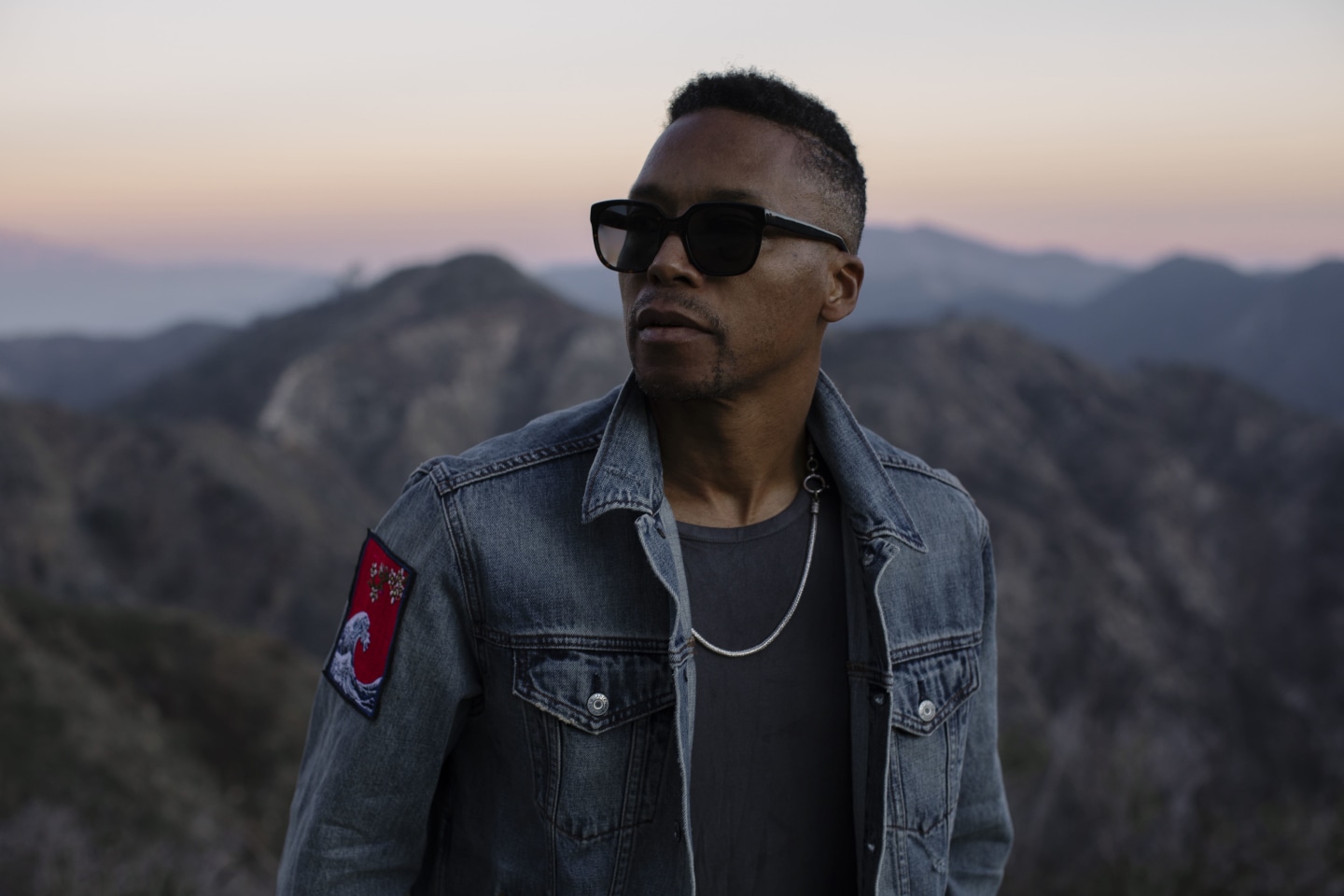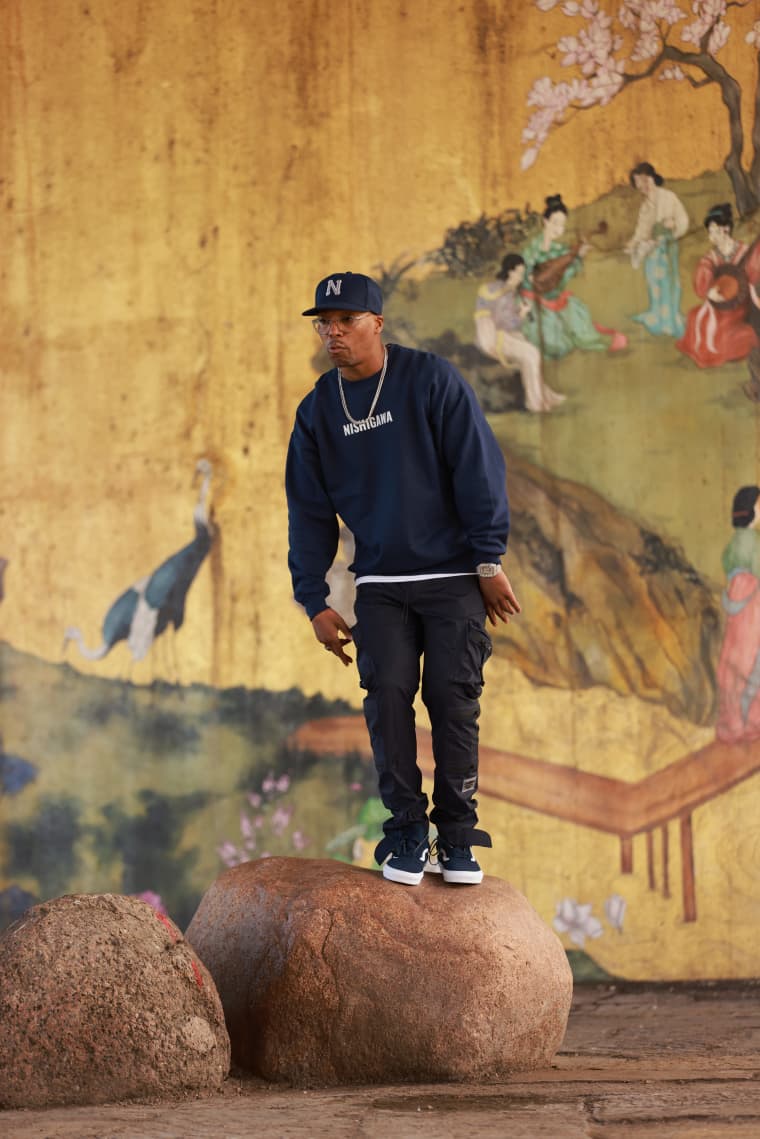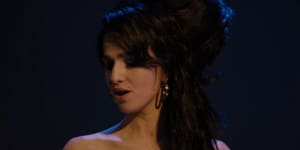 Lupe Fiasco. Photo via publicist.
Lupe Fiasco. Photo via publicist.
Lupe Fiasco’s creative process is more studied than most. Now 42, the Chicago MC born Wusalu Jaco has been rapping professionally for most of his life. His 2006 debut LP, Lupe Fiasco’s Food & Liquor, is widely regarded as a modern masterpiece, and he’s spent the ensuing 18 years honing his craft and teaching it — at his Society of Spoken Arts (SOSA) and in his Rap Theory & Practice course at MIT.
His latest album, Samurai, released on short notice late last month, stems from an unusual premise: a hypothetical scenario in which Amy Winehouse is a battle rapper. The concept isn’t entirely a figment of Lupe’s imagination; it comes from a voicemail Winehouse left for her producer, Salaam Remi, made public via Amy — the stunning 2015 documentary on the incomparable singer’s tragically brief life.
“I keep coming out with all battle raps — they’re just pouring out of me,” she says in the message. “Wu-Tang stuff — really neat, very beautifully alliterated little battle raps. So next time you wanna come for me and have a battle rap-off, I’m gonna kill you because I’m a samurai.”
Lupe has been outspoken about Samurai’s central conceit, discussing his inspiration openly in promotional interviews for the album. His portrait of Amy isn’t the first he’s made for an artist he admires: He’s recorded tributes to late legends like Dick Gregory and hip-hop peers such as Royce Da 5’9” — though the two later became embattled in a real-life rap beef — as well as elegies for child victims of the European refugee crisis and domestic gun violence. Some of these portraits have been publicly released, but he claims he’s kept many of them private, preferring to deliver them directly to the ears of the artists for whom he made them.
Absent his on-record statements, though, Samurai’s subject would be all-but unguessable. He drops small hints dropped here and there. The most direct comes in the hook of the record’s opener and title track, in which he quotes a passage from Winehouse’s voicemail to Remi verbatim: “I got these really neat / Very beautifully alliterated / Little battle raps for you.”
Other references are far more oblique — a recreation of our rap-warrior protagonist’s stage presence on “Bigfoot,” triumphant bars delivered in her ultra-confident persona on “Cake.” The project rarely strays into the biographical realm, never relying on the facts of Amy’s actual life while resisting the facility of a fictionalized 8 Mile hero arc.
Earlier this month, I called Lupe at an undisclosed location somewhere in the United States of America to talk about his indirect homage to Amy, rap research, and the art of portraiture.
The FADER: You’ve always had an affinity for concept albums, it seems. What appeals to you about having a concise, stated vision for a project?
Lupe Fiasco: It gives you a foundation and consistency to work from and an opportunity to go down different rabbit holes, as long as the overarching concept is still attended to from time to time. It’s a workflow thing, but it’s also an inspiration thing: When you find something that’s inspiring, there’s a lot of untapped content and vocabulary. It’s a cheat code.
Can you walk me through the process of expanding this germ of an idea — “What if Amy Winehouse was a battle rapper?” — into the album you just released?
If you start to ask a question like that, you have to answer it. And as you answer that question, there’ll be another question. [In this case], I had to make a song about how [Amy] got her battle rap powers. And then what did she do with them? When did she do it? Where did she do it? How good was it? And what was the reaction? It’s a chain of questions, and the album is how you choose to answer them.
“A portrait is supposed to express appreciation. It’s not a survey of a person or a list of their attributes.”
You’ve said you’re a deeper fan of jazz than any other genre at this point. What, in your opinion, makes a great jazz artist? And how does Amy embody that for you?
I don’t know what makes a great jazz artist; it’s up for them to decide. Different strokes for different folks, different ways to get to their skill levels. I just know what I like. Amy was a great songwriter, very technical. I never met her, but I got insight into her process through the documentary. She would practice writing to Thelonious Monk melodies. In jazz, you have these crazy melodies that aren’t just freestyle expressions; they’re actually charted out. The fact that she was attaching lyrics to music as abstract and asymmetrical as Monk’s… That was fucking fire. So I appreciate the technical aspect of it, but it’s also her tonal qualities, her voice, her attitude, her ability to perform.
Have you ever done that type of transcription in your own music?
Yeah. Transcription to melody is one of the courses we teach at SOSA. We try to find very complex melodies, or, in certain cases, [melodies] that are low-hanging fruit and well-known but have never kind of been transcribed. One we did was Dave Brubeck’s “Blue Rondo à la Turk,” which Nas actually did on one of his albums.
You do that [as a rapper]; you figure things out. It’s a great way to challenge yourself. It’s not something new. There are well-known hooks and choruses that are just transcriptions of nursery rhymes — I was thinking of one the other day, a Three 6 Mafia record. It’s sampling. That’s what hip-hop does.
Did you transcribe any of Amy’s melodies while you were writing this record?
No. I went back and listened to Back to Black, and I was like, “Nope, not doing that.” I wasn’t trying to recreate Amy from a biographical or musical standpoint. There were some records that didn’t make the album where there were some hints, like, “That might be something that she would do.” But in the end, I was like, “Nope, pull that. Let’s keep it very one to two, as opposed to being one to one.”
What about the Amy documentary inspired you to create a portrait of her, beyond the voicemail where she said she was writing battle raps?
It was just that statement. I never wanted to do the Amy Winehouse biography or try to rewrite her legacy. That’s for her estate. I’ve always respected her and loved her music, but in terms of making [the album] a portrait, it was just that. If that quote wasn’t in the film, you wouldn’t get Samurai. There might be references that would pop up here and there, but you wouldn’t get a completely dedicated project.
What generally inspires you to make a portrait of an artist?
Portraiture is one of the units in the class I teach at MIT, and there’s a set of rules and standards we put in play as to what it means to write a portrait. Some of them are self-generated, taking authority and liberty from me being Lupe Fiasco. We pull from other folks who’ve done portraiture as well — works like Nas’s “Unauthorized Biography of Rakim” — and then we take those frames to the classical understanding of what a portrait is meant to be: How does that translate from the visual space into the aural space? What other elements can we attach to it [in place of] what you lose in that transition?
The song “Samurai” was the original portrait of Amy, and it turned into a record beyond that. The original version of that song follows the standard rules of portraiture we teach at MIT. It had those pieces in there, but we had to remove them for sample clearance reasons, so [the final version] doesn’t.
I [make portraits of] people that I appreciate. That’s one of the rules. What I try to instill in my students when they do portraiture is to investigate, interview, be with the person as much as you can. A portrait is supposed to express appreciation; it’s not a survey of a person or a list of their attributes.
If you don’t have an experience with a person, you can’t make a portrait of them. But if you have to generate or curate that experience, that’s fine. That’s the thing: It’s not just sitting back at home and writing a rap based on your own thoughts. You have to engage with the person in a physical sense. I’m unable to do that with Amy, but the documentary acts as a stand-in for that.
 Lupe Fiasco. Photos via publicist.
Lupe Fiasco. Photos via publicist.

Did you use any source materials other than Amy’s music and the documentary when you were researching this project?
A lot of the project is imaginary. Even the samurai is reframed as this opera house thing. Taking these kinds of liberties in portraiture is fine to do as long as it’s grounded in a certain reality. Beyond that, the album is personal experiences, relying on my own expertise and authority from being a professional artist since I was 19 — record label dramas, awards, fan interactions, stalkers, heartbreak, the whole shit. You can apply that to many, if not all, artists.
When you don’t have much insight into a person’s life, you’re not trying to create a biography; you’re imagining new worlds to populate her in. If I didn’t tell you it was about Amy Winehouse, it could be about anybody.
“It’s a chain of questions, and the album is how you choose to answer them.”
Did you always plan on revealing that Amy was the inspiration for the album?
I mean, I revealed it as I was doing it. Samurai is a pandemic baby. We started in like 2020, so it was already known that I was writing a piece about Amy Winehouse. Was it ever meant to be released? Not really. It sat stagnant until my manager Chilly got out of prison and we sat in the studio and went through all the little projects I had in various stages. He was like, “No, that’s a record, that’s the joint,” so I was like, “Alright, cool, let’s finish it.” In terms of revealing the conceit, the only hesitation was not wanting it to infringe upon any type of intellectual property, or for people to look at it like I was just coming up off of her.
Whenever I do a portrait in this resurrective space, like a “Jonylah Forever” or an “Alan Forever,” or my portrait of Dick Gregory, it’s coming from a space of injecting new life and new spirit into something, as opposed to hijacking somebody’s legacy for my own benefit.
But then what are the limits of doing that? Are you authorized culturally? Legally? We did reach out to get clearances, and we went back and forth between the estate and the producers of the documentary, trying to figure out who to go to for a sample of a particular moment.
It got into a limbo space, so we went through the album and pulled out the direct samples and things that were too on the nose. We decided to take some creative liberties, and to let people know that while it’s inspired by Amy Winehouse, it’s not about Amy Winehouse’s life.
Since we’re taking creative liberties here, can you tell our readers what they’ve been dying to know?: If Amy Winehouse was a canonical battle rapper, who would she be?
Nope. She’d be the samurai.
